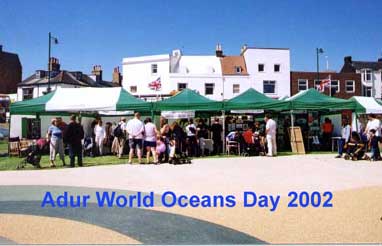
The
River Adur rises four miles south of Horsham and runs south-east skirting
Coolham, Shipley and West Grinstead before meeting the eastern tributary
midway between Ashurst to the west and Henfield to the east. The eastern
tributary rises in two tributaries south of Haywards Heath, and south Hassocks
that meet at Twineham. The River Adur reaches the sea at Shoreham-by-Sea
where the mouth has been deflected two miles to the east by the longshore
drift. Going upstream with the incoming tide
through the centre of New Shoreham, the flood tide will flow under seven
bridges before it reaches the
village of Bramber after 6.4 km (4 miles). The river then passes about
one mile east of the town of Steyning. The
estuary
is tidal for 17.9 km (11.1 miles) from the mouth to Bines Bridge on the
B.2135. Ref.
(link). The widest part of the estuary (excluding inlets) measured
in a direct north-south line from the Bridge Hotel slipway (Norfolk Bridge)
to Riverbank, Shoreham beach is approx 350 metres wide on a flood spring
tide of 6 metres and above.
 |
 |
The
new Adur Ferry Bridge
Opening
Day 13 November 2013 & under construction
March
2013
At low tide the River Adur cuts a narrow fast running channel through the mud flats in the middle of Shoreham-by-Sea as it rushes out to sea through the two long piers that mark the entrance to Shoreham Harbour.
The
river is at its most interesting at mid-tide when half the mud
flats are revealed. The mud flats become a roost for gulls and other
birds, especially during the winter. Waders and birds on the mud include
Ringed Plover, Dunlins and Lapwing, which are all commonly seen in the
colder months. Redshanks sound the first warning at the anticipation
of danger. Boats and wooden posts are occupied by Cormorants fanning their
wings after feeding on eels and flatfish.
Estuary
Wildlife
Andy Horton presents an illustrated talk for children and another one for adults called a "A Portrait of the River Adur". Please enquire about talks and the the presentation package for schools.
PROJECT RIVER
ADUR
Education
Resource for Schools
The river is build up on both sides through the low-lying flood plain and their are few marshes or wetlands aside the river. Flooding occurred at the beginning of the century at Bramber (notably in 1904) but this rarely occurs. There are pleasant walks on the towpaths on both sides of the river, from Shoreham-by-Sea to Bramber, with the passage passable for bicycles, if you can put up with lifting your bicycle over a few stiles.
Patchwork landscape of the Adur Valley from Mill Hill
The
River Adur at low tide, looking south-east towards the downs north of Mill
Hill in the background.
The
footbridge on the right in the photograph is the part of the South Downs
Way after it descends steeply into the Adur Valley. This part of the river
is between one and two miles north of Old Shoreham and the Toll
Bridge.
Chub released at * Tenchford Bridge (near Shipley) and Lock Farm (February 1999) western arm of the Adur.
The
Sakeham catchment area for the east tributary covers 93.3 sq. km and runs
through Weald clay where there is a rapid run-off for 54% of the precipitation,
and to the north of the main run of the east river there is sandstone where
there is natural water storage and the flow in the river is less affected
by the immediate rainfall.
(It is not easy to explain the steepness of the
eastern and western boundaries of the Adur Valley cutting through the South
Downs north of Shoreham, although they may have been created by melt water
during periglacial times).
Explanation
(in the course of completion: at first draft stage)
Also,
see Devil's
Dyke South Downs site
At about AD 965
the shoreline was different from the present. The River Adur was navigable
as far upstream as Beeding or Bramber about four miles to the north of
Old Shoreham. At the time of Edward the Confessor (1042-1066) ships could
reach St. Cuthmans (Portus Cuthmanni) (Steyning), a further mile
north, which was a thriving port. The first bridge
crossing at Bramber erected at the time of Bramber Castle (now in
ruins) about AD 1086 sometimes prevented navigation further upstream
(1103). A timber quay was erected at Bramber about this time (between AD
1010 and 1170).
Link
to the Old River Course in Medieval Times
The new Adur Swing Bridge at high tide
The
river has also been known as the Sore (Holinshed's
Chronicle 1577). This is likely to be because of back-formation. Back-formation
is the reverse of affixation, being the analogical creation of a new word
from an existing word falsely assumed to be its derivative. (i.e. Sore
arose after the name Shoreham and not the other way round).
In
late Saxon times the river was known as be
eastern bremre, ofer bremre 956 (Bramber).
Toponymy:
Shoreham-by-Sea and Adur
River
Adur at Dusk
View
of the Adur Ferry Bridge from the Norfolk Bridge
Important Places
in the Adur Valley:
Upper
Beeding
Upper
Beeding (2)
Botolphs
(church of St. Botolphs)
Upper
Beeding (church of St. Peter)
Bramber
(church of St. Nicholas)
Henfield
East:
Twineham
Wineham
Hickstead
West:
Partridge Green
West Grinstead
Shipley
Coolham
Cowfold
Internet
Services/Web Page Design
If
you do not receive a reply or acknowledgement to an EMail within four weeks,
please write again

ADUR VALLEY EFORUM PAGE |
Adur
District Council (External)
Adur
On-Line (External)
Adur
District: Political
Adur:
Nature Notes 2008
Adur:
Nature Notes 2002
Adur
Wildlife 2007
Adur
Wildlife Gallery (Image Portfolio)
Adur
Wildlife Gallery (CD-ROM only)
Adur
World Oceans Day 2008

Chalk
Rivers Biodiversity (JNCC)
Estuary
Wildlife & Environment
First
Millennium (start of)
Lancing
College
Map
of the Adur Area
River
Adur Slide Show (by Ray Hamblett)
Salt-making
(Saxon-Norman, History file)
Shermanbury
(Adur Valley
Shoreham-by-Sea
Home Page
Shoreham-by-Sea
Wildlife Habitats
Shoreham
Sailing Club (External)
Sussex
Archaeological Society
Sussex
Archaeological Society EGroup
Sussex
Ornithological Society
Toll
Bridge Comparisons
West
Sussex County C.C. Population Statistics
Widewater
Lagoon
Zones
of the Lower River Adur
 THE
ADUR ESTUARY
THE
ADUR ESTUARY
A
SURVEY OF THE MARINE FLORA AND FAUNA
1960
TO 1992

| Shoreham-by-Sea |
| Chalk Downs |
| Coastal Fringe |
| Intertidal (Seashore) |
| Lancing Ring |
| River Adur Estuary |
| River Adur Flood Plain |
| Sea (off Sussex) |
| Town & Gardens |
| Widewater Lagoon |
Local Wildlife Links (SE England)
Adur
Nature Notes
Adur
Valley Wildlife
Dungeness,
Kent, England
Havant
Nature Notes
Lancing
Ring
Orford
Ness: Coastal Ecology of a Shingle Bank (excellent references)
Ralph
Hollins Nature Pages (Chichester Harbour area)
Rye
Harbour Nature Reserve
Rockpooling
Page
Seashore
Page
Shingle
Coast (Coastal Fringe of Shoreham Beach)
Shoreham-by-Sea
Wildlife Page
Sussex
Archaeological Society
Sussex
Archaeological Society EGroup
Sussex
Archaeology & Folklore
Sussex
Wildlife Web Sites